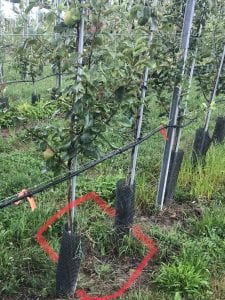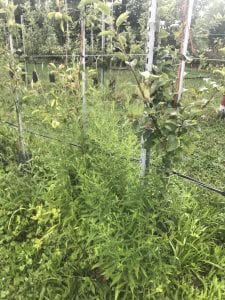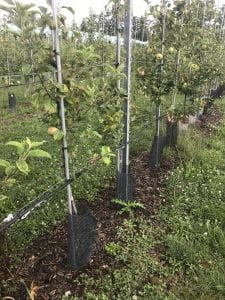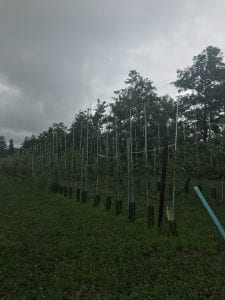 One of the research projects at the orchards that I have assisted with is collecting weed samples in the orchard. This research project is being conducted under Honey-crisp trees grafted on a Bud 9 rootstock managed in an organic system. The bud 9 rootstock is cold-hardy and has a dwarfing effect on the honey crisp variety, and the trees are planted onto a high density system. Research for this project started in 2016, and contains different treatment practices for weed control and soil health. The treatments include mulch, tilling with an implement by Harris Mackey called the Wonder Weeder, weed whacking, 2 organic sprays (Suppress and Final-San-O) and a control area. Ultimately, the research project aims to see which weeds grow under different management systems, the biomass of those weeds, which system yields higher soil health levels, and the overall horticultural performance of different management systems.
One of the research projects at the orchards that I have assisted with is collecting weed samples in the orchard. This research project is being conducted under Honey-crisp trees grafted on a Bud 9 rootstock managed in an organic system. The bud 9 rootstock is cold-hardy and has a dwarfing effect on the honey crisp variety, and the trees are planted onto a high density system. Research for this project started in 2016, and contains different treatment practices for weed control and soil health. The treatments include mulch, tilling with an implement by Harris Mackey called the Wonder Weeder, weed whacking, 2 organic sprays (Suppress and Final-San-O) and a control area. Ultimately, the research project aims to see which weeds grow under different management systems, the biomass of those weeds, which system yields higher soil health levels, and the overall horticultural performance of different management systems.
To collect data, we first place square outline of PVC pipes on the ground between trees. After the target area is defined, my supervisor would take a picture of the area to collect data on the percentage of weed cover in the plot. Next, we cut the weeds at surface level, and then sort them out into bags labeled with their variety. We would then dry the weeds and weigh them to note the biomass levels. I have not tested soil health, but soil samples are sent to the Soil Health lab at Cornell to assess this data point. This process is repeated every month to see the change in varieties and repeated across many rows in the orchard to account for different factors that could be present across rows and trees.
This diagram shows what area we would harvest weeds from in the orchard. Some plots have much more weeds than this and many more varieties. This research project has been useful in my ability (or lack thereof) to identify weeds that grow in the area! This plot looks like could be part of the organic spray section, but I am unsure which spray was used in this area.
In this picture, you can see the difference in weed biomass and species that are present in the research trial. I would guess that this section would be in the “control’ category, meaning that we have not had any weed control interference in the plot. These weeds are most likely competing with the trees for nutrients and could grow to be very unruly if left alone.
The following picture is the mulch section of the trial. From my observations, this treatment seems to prevent weeds the best when compared to the other treatments.
The next picture is of the “Wonder Weeder” plots. This cultivation implement is attached to the front of the tractor, and the speed is dictated by the speed of the tractor. Cultivation with this tool is fairly shallow, so the soil health levels are not majorly impacted. My supervisors like this tool for orchard weed management, because it allows them to get close to the trees and see the area they are tilling from the front hitch attachment. I have also attached an image of the implement to get a better idea of what it looks like.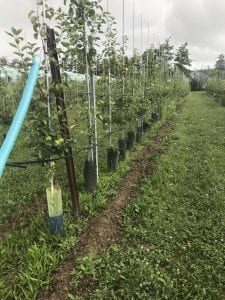
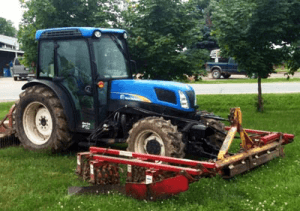 photo-MSU Extension
photo-MSU Extension
After we weigh the weeds, we input the data into a excel spreadsheet that is formulated to allow my supervisor to see how much of the biomass was composed of which species. Hopefully later, they will be able to share scientific-based recommendations on which weed control method prevents certain weeds and total weed cover for organic apple orchards!

